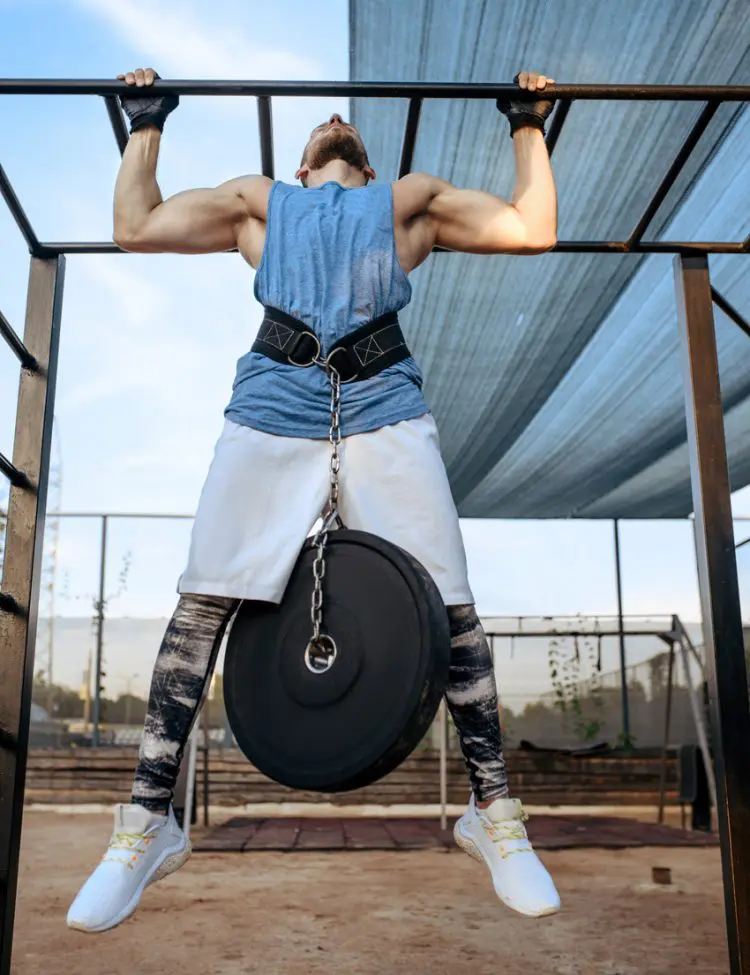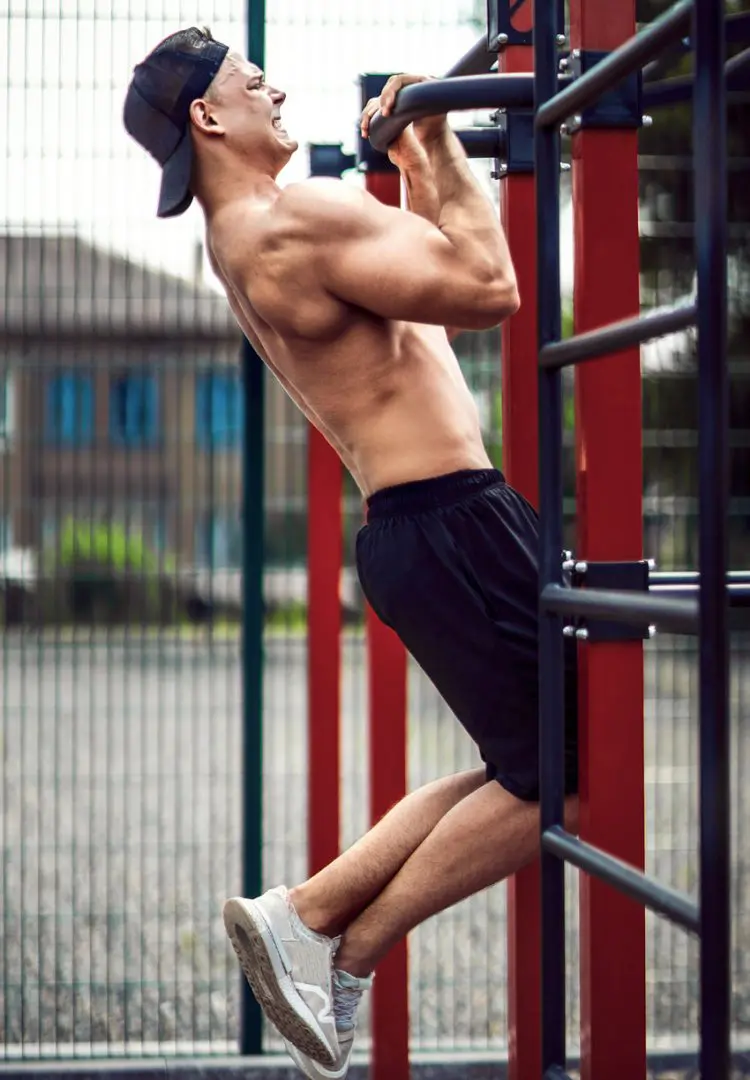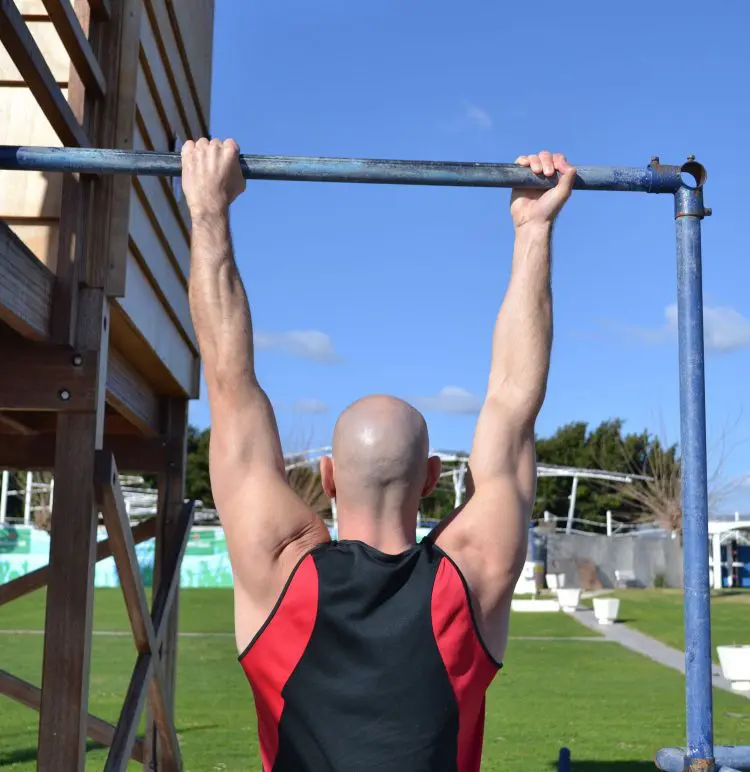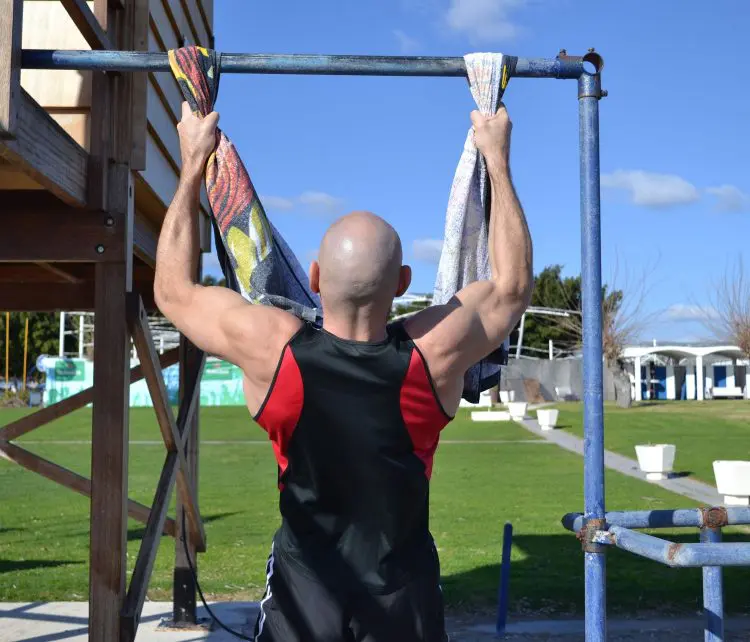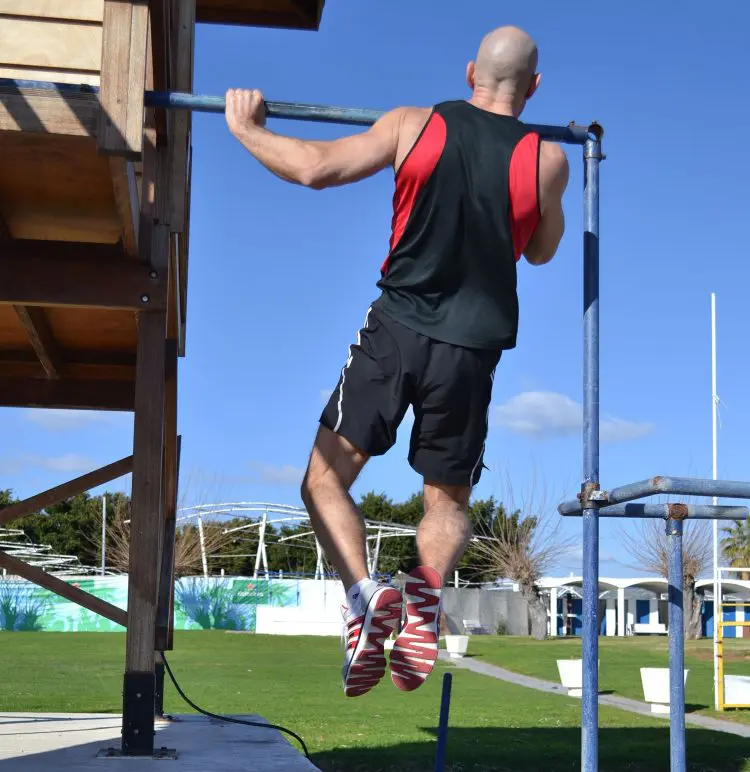When it comes to chin-ups and pull-ups, a lot of lifters get confused. Which is which, they ask!
Chin-ups are done with a shoulder-width or narrower underhand (supinated) grip. Chin-ups can also be done with using a neutral or palms inward grip. In contrast, pull-ups are done with an overhand (pronated) shoulder-width or wider grip.
Both chin-ups and pull-ups work your latissimus dorsi or lats, lower traps, posterior deltoids, and pectoralis minor, not to mention your biceps. However, chin-ups put your biceps in a mechanically advantageous position so that many exercisers find them marginally easier than pull-ups.
As effective as conventional chin-ups and pull-ups undoubtedly are, there is more than one way to do these exercises. There is nothing wrong with just hanging from a bar and cranking out some reps, but if your progress has stalled or you are bored with the same old back workout, some variation can help.
The good news is that are lots of chin-up and pull-up variations you can use to liven up your training. We’re not talking about things like lat pulldowns or rows here, both of which are alternatives rather than variations. Instead, we mean exercises that involve pulling your body weight up to an overhead bar using your arms.
Level Up Your Fitness: Join our 💪 strong community in Fitness Volt Newsletter. Get daily inspiration, expert-backed workouts, nutrition tips, the latest in strength sports, and the support you need to reach your goals. Subscribe for free!
So, if you’ve had enough of standard chin-ups and pull-ups, give one of our best 21 variations a try.
Still working on mastering chin-ups and pull-ups? Check out Pull-Ups Vs. Chin-Ups guide to learn all there is to know about these cornerstone exercises.
The 21 Chin-Up and Pull-Up Variations
Whether you want to build muscle, get stronger, or increase your chin-up/pull-up performance, these variations will help. Use them in place of conventional chin-ups or pull-ups or as a secondary assistance exercise after your main workout. Or, if you usually do chin-ups or pull-ups twice a week, use your choice of alternatives to make up your second workout.
0. Do chin-ups instead of pull-ups or vice versa
Before we reveal the 21 best chin-up and pull-up variations, remember that we’re actually talking about two different exercises already.
So, if you usually do chin-ups, try switching to pull-ups to add some variety to your workouts. Or, if pull-ups are your go-to back-builder, make the change to chin-ups. Once you’ve explored this option, try any of the following 21 variations.
1. Band assisted chin-ups and pull-ups
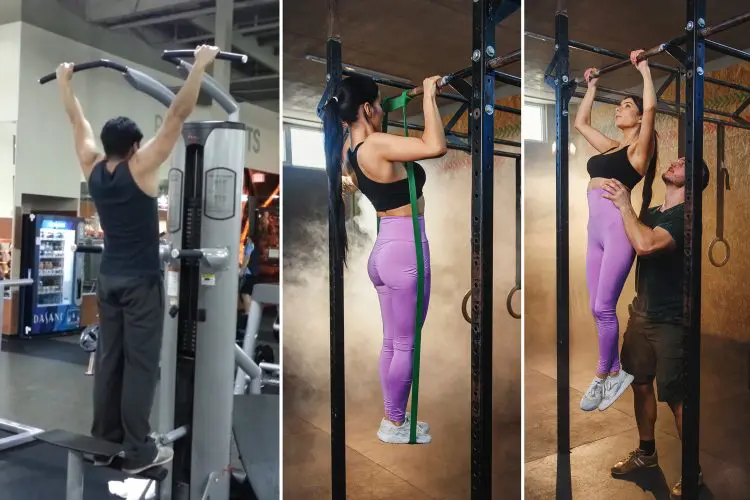
Band assisted chin-ups and pull-ups are also useful for more advanced exercisers. Use a band so you can do more reps per set and in your warm-ups to prep your muscles for your planned workout. You can also use bands to make more advanced chin-up and pull-up variations easier to learn, e.g., single-arm chin-ups or plyo pull-ups.
2. Weighted chin-ups and pull-ups
Using just your body weight for resistance, your main mode of progression is doing more reps per set. That’s okay if your body weight takes you to failure within your preferred rep range, but what if you can do more reps?
Put on a weighted vest, use a chin/dip belt, attach resistance bands to your ankles, or drape chains over your shoulders. However, you do it, increasing your body weight will help build muscle size and strength.
Start off with 5-10% of your body weight. Remember, you are already lifting your entire body, and you won’t need to add much weight to make your chosen exercise a whole lot harder.
3. 3-count eccentric chin-ups and pull-ups
You are stronger eccentrically than you are concentrically. In other words, you can lower more weight than you can lift. Make the most of this phenomenon with 3-count eccentric chin-ups and pull-ups.
To do this exercise, pull yourself up as usual and then lower yourself down for a slow count of three. Too easy? Descend in five instead. This strategy will make any chin-up or pull-up variation more demanding and effective.
4. Paused chin-ups and pull-ups
Adding a mid-rep pause increases your time under tension, which is useful for hypertrophy. There are three main places you can add pauses to chin-ups and pull-ups:
- Halfway up with your arms bent to around 90 degrees
- At the top of each rep
- Halfway down with your arms bent to around 90 degrees
Pause for 2-5 seconds in one of these positions or, for a real butt-kicking workout, pause in all three.
5. Hockey-grip chin-ups
Hockey-grip chin-ups, also known as commando-grip chin-ups, allow you to use a neutral grip even if you don’t have the appropriate handle. A lot of lifters find neutral grip chin-ups cause less elbow pain than fully supinated chin-ups or pronated pull-ups.
How to do it:
- Stand sideways beneath your pull-up bar. Grip the bar so that both hands are facing inward. Your thumb on one hand should be touching the little finger of the other hand.
- Hang with your feet clear of the floor, arms straight, and core braced. Pull your shoulders down and back.
- Pull yourself up, so your head travels out to one side of the bar. Try to touch the bar with your shoulder.
- Extend your arms and descend under control.
- Pull yourself up but, this time, go to the other side of the bar.
- Alternate sides rep by rep and, for your next set, swap your hands around too.
6. Wide-grip pull-ups
The wider apart you place your hands, the harder pull-ups become. Old-school bodybuilders used to think that a wide grip built wider lats, but this isn’t really the case. In fact, the wider your grip, the smaller the range of motion is for your shoulders and lats. But that doesn’t mean wide-grip pull-ups don’t have merit. After all, they are more challenging than most narrower grip variations.
Take care, though; very wider grip pull-ups can be hard on your shoulders. Avoid this variation if you experience any shoulder pain.
7. Narrow-grip chin-ups and pull-ups
Just because chin-ups and pull-ups are usually done with a specific width grip doesn’t mean you always have to do them that way.
Try moving your hands much closer together to change the feel of your chosen exercise. You can do both chin-ups and pull-ups with a narrow grip. How narrow? Try doing them with your hands just a few inches apart or even touching.
8. Gymnastic ring chin-ups
Both underhand chin-ups and overhand pull-ups can cause elbow pain. Using a fixed bar forces you into an unmodifiable movement pattern that can put a lot of strain on your joints. Gymnastic rings rotate so that you can modify your hand position to match your anatomical requirements. If chin-ups or pull-ups hurt your elbows, try using gymnastic rings.
Lots of gyms have gymnastic rings, or you can buy your own. Just attach them to your usual pull-up bar and get repping!
9. Mixed-grip pull-ups
Do you like pull-ups and chin-ups equally? Can’t choose between them? Why not do them both at the same time! For this variation, use an underhand grip AND an overhand grip.
This exercise is a useful progression before attempting single-arm chin-ups. Try to do more work with your supinated arm than your pronated arm. Use your pronated arm less and less as you get stronger. Think of this exercise as self-spotted one-arm chin-ups. Make sure you swap hands set by set.
Level Up Your Fitness: Join our 💪 strong community in Fitness Volt Newsletter. Get daily inspiration, expert-backed workouts, nutrition tips, the latest in strength sports, and the support you need to reach your goals. Subscribe for free!
10. Kipping pull-ups
Kipping pull-ups have little value if you want to build muscle. They take the stress off your lats and biceps, essentially making pull-ups easier.
But, if your aim is to do more reps, kipping pull-ups can be very useful. CrossFitters use this technique to help them crank out more reps in less time. They’re also a critical part of muscle-ups – our next variation.
How to do it:
- Hang from a sturdy overhead bar using a shoulder-width, overhand grip. Your arms should be straight, and your shoulders pulled down and back. Brace your core and extend your legs very slightly in front of you, so your body forms a hollowed position.
- Swing your legs backward and then forward again, simultaneously flexing your lats. At this point, you should be leaning back.
- Using this momentum, pull hard with your arms and heave your chest up toward the bar. Your aim is to pull your chest above the height of the bar.
- Descend and repeat, trying to establish a smooth, continuous rhythm.
11. Straight bar muscle-ups
Straight bar muscle-ups combine kipping pull-ups with dips. These two movements are blended into one and work your entire upper body. Part gymnastics movement, and part power builder, the straight bar muscle-up is a CrossFit exercise and very challenging to learn and master.
It’s beyond the scope of this article to teach you how to do straight bar muscle-ups, but you can read all about this exercise in our in-depth guide.
12. Plyo chin-ups and pull-ups
You’ve probably done clapping plyo push-ups, but how about clapping chin-ups and pull-ups? For this variation, pull yourself up as hard and as fast as you can.
At the top of your rep, briefly release the bar and, if you’ve got time, clap your hands. Re-grip the bar and descend as normal. Too easy? Try switching from a pronated to a supinated grip at the top of each rep!
13. Single-arm assisted chin-ups
Do you want to win a wager? This could be the exercise to do it! Bet your gym buddies you can do a one-arm chin-up. They probably won’t believe you. Then grab an overhead bar with one hand and grip your own wrist with the other.
Bend your arms and pull yourself up until your chin touches the bar. Descend smoothly, and, if you’re still feeling strong, pump out another rep or two. You can then officially crown yourself king of the gym.
This is more than just a way to fool and fleece your workout buddies; it’s also a legitimate exercise. Use it to strengthen your grip and start working toward doing genuine single-arm chin-ups.
14. Single-arm chin-ups
Just because you can do ten regular chin-ups does not mean you’ll be able to do five using only one arm. Some people will never be able to do single-arm chin-ups, as it’s an exercise that requires not just lots of strength but great genetics too.
But that doesn’t mean you shouldn’t train for one-arm chin-ups. If nothing else, your efforts will undoubtedly increase your regular chin-up performance.
One way to work up to doing one-armed chin-ups is to grip the bar with one hand and a towel with the other. As you get stronger, move your hand further down the towel to reduce your purchase and your ability to use it.
Alternatively, you can use a resistance band for assistance or do eccentric-only single-arm chin-ups to build the requisite strength for this tough-as-nails exercise.
15. Towel grip chin-ups
Towel grip chin-ups are one of the best ways to build an unbreakable grip. Simply loop a couple of towels over your bar and hold the ends tightly.
Use an underhand, neutral, or overhand grip as preferred. Don’t be surprised if you can’t do as many as usual! This exercise is useful for military personnel as it closely replicates the upper body demands of climbing a rope.
16. Jumping chin-ups and pull-ups
This variation turns what is usually an upper body strength training exercise into a full-body cardio workout. It’s an ideal movement for circuit training.
How to do it:
- Stand below your pull-up bar with your feet about shoulder-width apart. Descend into a quarter-depth squat and then leap upward.
- Grab your pull-up bar with an overhand or underhand grip and use the momentum from your jump to help you pull your chin up and over the bar.
- Lower yourself down, release the bar and drop to the floor, and then repeat.
- Turn this exercise into a pull-up burpee by doing a push-up between reps.
17. Eccentric-only chin-ups and pull-ups
Even if you are yet to do your first chin-up or pull-up, this is a handy exercise to know. As mentioned before, you are stronger eccentrically than you are concentrically. Just because you can’t pull yourself up to do chin-ups and pull-ups doesn’t mean you can’t lower yourself down.
Place a bench under your bar, climb up, grab the bar with an underhand or overhand grip, and then lower yourself down using just your arms. Descend under control; don’t just drop down. Climb back up and repeat, continuing until you are unable to control your descent. Training like this will help you build the strength needed to do full pull-ups or chin-ups.
Intermediate and advanced exercisers can use this variation too. Strap on some extra weight and use eccentric-only reps to increase your strength by exposing your muscles to more weight than usual.
18. Side to side pull-ups
This is a useful exercise for rock climbers, who often have to pull themselves up sideways and not just vertically. It’s also a good exercise for developing the strength necessary for one-arm chin-ups as it overloads one arm at a time.
How to do it:
- Grab the bar with an overhand, shoulder-width grip.
- Bend your arms and pull your chin up and over to one hand.
- Descend and then pull yourself up and over to the other side.
- Continue alternating sides for the duration of your set.
- Alternatively, once you’ve pulled your chin up and over to your hand, move across the bar and touch your chin the other side before descending. If using this method, make sure you alternate which hand you touch first.
19. Super-slow chin-ups and pull-ups
Unless you are doing kipping pull-ups, you should generally do your chin-ups and pull-ups with a smooth, deliberate tempo, such as two seconds up and two seconds down. This helps eliminate momentum and will make your workout more effective. Going slower increases time under tension and makes every rep you perform more demanding.
For this variation, instead of using a 2:2, 3:3, or even a 5:5 tempo, you are going to slow right down and use a 30:30 tempo, meaning you take 30 seconds to pull yourself up and 30 seconds to lower yourself down.
This keeps your muscles under tension for 60 muscle-building seconds and turns what is already a demanding exercise into a real challenge for survival!
With an eye on the clock, grab the bar with an overhand or underhand grip. Take 30 seconds to pull your chin up to the bar. Do not stop moving – locking off is cheating. Instead, move slowly and deliberately. Once you’ve reached the bar, immediately start your descent. Again, no pausing allowed; keep moving, albeit very slowly.
You should only want or be able to do one rep of this exercise. If you feel you could have done more, add weight or take longer to complete your rep, i.e., 35:35.
20. L-sit chin-ups and pull-ups
Chin-ups and pull-ups both involve your core, but that involvement is not very significant. You have to use your core to stabilize your legs and stop them from swinging. L-sit chin-ups and pull-ups are much more core-centric.
How to do them:
- Grab the bar with an underhand or overhand grip as preferred. Lift your legs and hold them parallel to the floor.
- Bend your arms and pull your chin up and over the bar.
- Lower yourself down smoothly and repeat.
- Keep your legs up for the duration of your set or raise and lower them rep by rep as preferred.
- Make this exercise easier by bending your legs and tucking your knees to your chest.
21. Crossover chin-ups and pull-ups
This is another pull-up variation that increases core activation. This time, it works your obliques, as well as your rectus abdominus.
How to do it:
- Hold your bar with an underhand or overhand grip. Brace your abs and lift your chest, pulling your shoulders down and back.
- Bend your arms and pull your chin up and over the bar.
- Simultaneously bend one leg and pull your knee up and across toward your opposite elbow. Don’t worry if they don’t touch; so long as your knee travels in that general direction, you’ll feel this exercise working your abs and obliques.
- Descend and lower your legs, and then do a rep on the opposite side.
Wrapping Up
Pull-ups and chin-ups are two of the best upper body exercises you can do. Whether you want to get bigger or stronger, these moves deserve to be part of your workouts. It doesn’t matter if you are a man or woman, a bodybuilder or powerlifter; you should be able to do at least a few chin-ups or pull-ups.
But, as good as the conventional versions of these exercises are, you don’t have to use them exclusively. There is plenty of room for variation in your workouts. And, with 21 different chin-ups and pull-ups to try, your back workouts need never be repetitive or boring.
Use these chin-up and pull-up variations to keep your workouts fresh, interesting, and fun!


